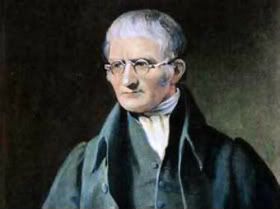Democritus (460 B.C.)developed the idea of atoms.
 He asked this question: If you break a piece of matter in half, and then break it in half again, how many breaks will you have to make before you can break it no further? Democritus thought that it ended at some point, a smallest possible bit of matter. He called these basic matter particles, "atomos", meaning indivisible.
He asked this question: If you break a piece of matter in half, and then break it in half again, how many breaks will you have to make before you can break it no further? Democritus thought that it ended at some point, a smallest possible bit of matter. He called these basic matter particles, "atomos", meaning indivisible.
Aristotle dismissed the atomic idea as worthless.

People considered Aristotle's opinions very important and if Aristotle thought the atomic idea had no merit, then most other people thought the same also.
Not until the early 1800's did people begin again to question the structure of matter.
In 1897, the English physicist J.J. Thomson discovered the electron and proposed a model for the structure of the atom.
Thomson knew that electrons had a negative charge and thought that matter must have a positive charge. His model looked like raisins stuck on the surface of a lump of pudding.
In 1911 Ernest Rutherford thought it would prove interesting to bombard atoms with these alpha rays, figuring that this experiment could investigate the inside of the atom (sort of like a probe). He used Radium as the source of the alpha particles and shinned them onto the atoms in gold foil. Behind the foil sat a fluorescent screen for which he could observe the alpha particles impact.
The results of the experiments came unexpected. Most of the alpha particles went smoothly through the foil. Only an occasional alpha veered sharply from its original path, sometimes bouncing straight back from the foil! Rutherford reasoned that they must get scattered by tiny bits of positively charged matter. Most of the space around these positive centers had nothing in them. He thought that the electrons must exist somewhere within this empty space.
Rutherford thought that the negative electrons orbited a positive center in a manner like the solar system where the planets orbit the sun.
Rutherford's atom
Rutherford knew that atoms consist of a compact positively charged nucleus, around which circulate negative electrons at a relatively large distance. The nucleus occupies less than one thousand million millionth (10 ) of the atomic volume, but contains almost all of the atom's mass. If an atom had the size of the earth, the nucleus would have the size of a football stadium.
Not until 1919 did Rutherford finally identify the particles of the nucleus as discrete positive charges of matter. Using alpha particles as bullets, Rutherford knocked hydrogen nuclei out of atoms of six elements: boron, fluorine, sodium, aluminum, phosphorus, an nitrogen. He named them protons, from the Greek for 'first', for they consisted of the first identified building blocks of the nuclei of all elements. He found the protons mass at 1,836 times as great as the mass of the electron.
But there appeared something terribly wrong with Rutherford's model of the atom. The theory of electricity and magnetism predicted that opposite charges attract each other and the electrons should gradually lose energy and spiral inward.
In 1912 a Danish physicist, Niels Bohr came up with a theory that said the electrons do not spiral into the nucleus and came up with some rules for what does happen. (This began a new approach to science because for the first time rules had to fit the observation regardless of how they conflicted with the theories of the time.)
Bohr said, "Here's some rules that seem impossible, but they describe the way atoms operate, so let's pretend they're correct and use them." Bohr came up with two rules which agreed with experiment:
RULE 1: Electrons can orbit only at certain allowed distances from the nucleus.
RULE 2: Atoms radiate energy when an electron jumps from a higher-energy orbit to a lower-energy orbit. Also, an atom absorbs energy when an electron gets boosted from a low-energy orbit to a high-energy orbit.






No comments:
Post a Comment